Haryana State Board HBSE 9th Class Maths Important Questions Chapter 2 Polynomials Important Questions and Answers.
Haryana Board 9th Class Maths Important Questions Chapter 2 Polynomials
Very Short Answer Type Questions
Question 1.
Write the coefficients of x3 in each of the following :
(i) 4x3 – 3x + 9
(i) 14 – 5x3 + 7x + 2x2
(iii) \(\frac {3}{4}\)x3 + 7x – 9
(iv) 5x2 + \(\sqrt{3}\)x + 1
(v) \(\sqrt{5}\)x3 + x2 + 7
(vi) x – x3
Solution :
(i) The coefficient of x3 in 4x3 – 3x + 9 is 4.
(ii) The coefficient of x3 in 14 – 5x3 + 7x + 2x2 is – 5.
(iii) The coefficient of x3 in \(\frac {3}{4}\)x3 + 7x – 9 is \(\frac {3}{4}\).
(iv) The coefficient of x3 in 5x2 + \(\sqrt{3}\)x + 1 is 0.
(v) The coefficient of x3 in \(\sqrt{5}\)x3 + x2 + 7 is
(vi) The coefficient of x3 in 1 – 13 is – 1.
![]()
Question 2.
Write a monomial of degree 30, a binomial of degree 50 and a trinomial of degree 60.
Solution:
Monomial of degree 30 = x30
Binomial of degree 50 = 3x50 + 5
Trinomial of degree 60 = 5x60 + x + 7.
Question 3.
Classify the following as linear, quadratic, cubic and biquadratic polynomials:
(i) 3x2 + 4x + 7
(ii) x2 – x3
(iii) 1 + t
(iv) 5x4 + 2x3 + x + 5
(v) y3 + 3y2 – 5
(vi) y2 + 7y
(vii) t2
Solution:
(i) Degree of the given polynomial is 2. So it is the quadratic polynomial.
(ii) Degree of the given polynomial is 3. So, it is the cubic polynomial.
(iii) Degree of the given polynomial is 1. So, it is a linear polynomial.
(iv) Degree of the given polynomial is 4. So, it is a biquadratic polynomial.
(v) Degree of the given polynomial is 3. So, it is a cubic polynomial.
(vi) Degree of the given polynomial is 2. So, it is a quadratic polynomial.
(vii) Degree of the given polynomial is 2. So, it is a quadratic polynomial.
Question 4.
Find the values of the polynomial x3 – 2x2 + 3x + 5 at:
(i) x = 0
(ii) x = 1
(iii) x = – 2.
Solution:
Let p(x) = x3 – 2x2 + 3x + 5
(i) At x = 0, the value of the polynomial p(x) is given by
p(0) = (0)3 – 2 × (0)2 + 3 × 0 + 5
= 0 – 0 + 0 + 5 = 5
Hence, p(0) = 5.
(ii) At x = 1, the value of the polynomial p(x) is given by
p(1) = (1)3 – 2 × (1)2 + 3 × 1 + 5
= 1 – 2 + 3 + 5 = 7
Hence, p(1) = 7.
(iii) At x = – 2, the value of the polynomial p(x) is given by
p(-2) = (-2)3 – 2 × (-2)2 + 3 × (-2) + 5
= – 8 – 8 – 6 + 5
= – 22 + 5 = – 17
Hence, p(-2) = – 17.
![]()
Question 5.
Find the remainder when x4 – x3 – 2x2 + 4x – 10 is divided by x + 2.
Solution :
Let
p(x) = x4 – x3 – 2x2 + 4x – 10
We know that when p(x) is divided by (x + 2), the remainder is p(-2).
(By Remainder Theorem)
So, p(-2) = (-2)4 – (-2)3 – 2 × (2)2 + 4 × (-2) – 10
= 16 + 8 – 8 – 8 – 10
= 16 – 18 = – 2
Hence, the required remainder = – 2.
Question 6.
Find the remainder when x3 – 2x2 – 11x + 15 is divided by x + 3.
Solution:
Let
p(x) = x3 – 2x2 – 11x + 15
We know that when p(x) is divided by (x + 3) the remainder is p(-3).
[By Remainder Theorem]
So, p(-3) = (-3)3 – 2 × (- 3)2 – 11 × (-3) + 15
= – 27 – 18 + 33 + 15
= 48 – 45 = 3.
Hence, the required remainder = 3.
Question 7.
Determine the value of k, such that (x + 3) is a factor of the polynomial f(x) = 2x3 + 11x2 + kx + 6.
Solution :
We have,
f(x) = 2x3 + 11x2 + kx + 6
If (x + 3) is a factor of f(x), then by factor theorem, the remainder f(-3) should be zero.
⇒ f(-3) = 0
⇒ 2x(-3)3 + 11 × (-3)2 + k × (-3) + 6 = 0
⇒ – 54 + 99 – 3k + 6= 0
⇒ – 3k + 105 – 54 = 0
⇒ – 3k + 51 = 0
⇒ -3k = – 51
⇒ k = \(\frac {-51}{-3}\) = 17
Hence, k = 17.
Question 8.
Find the value of a, if x – a is a factor of x3 – ax2 + 2x + a – 1. [NCEAT Exemplar Problems]
Solution :
Let p(x) = x3 – ax2 + 2x + a – 1
If (x – a) is a factor of p(x), then by factor theorem, the remainder p(a) should be zero.
⇒ p(a) = 0
⇒ (a)3 – a × (a)2 + 2 × a + a – 1 = 0
⇒ a3 – a3 + 2a + a – 1 = 0
⇒ 3a – 1 = 0
⇒ 3a = 1
⇒ a = \(\frac {1}{3}\)
Question 9.
If (x – 2) is a factor of the polyomial x5 – 3x4 – kx3 + 3kx2 + 2kx + 4, find the value of k.
Solution :
Let p(x) = x5 – 3x4 – kx3 + 3kx2 + 2kx + 4
If (x – 2) is a factor of p(x), then by factor theorem, the remainder p(2) should be zero
⇒ p(2) = 0
⇒ (2)5 – 3 × (2)4 – k × (2)3 + 3k × (2)2 + 2k × 2 + 4 = 0
⇒ 32 – 48 – 8k + 12k + 4k + 4 = 0
⇒ 36 – 48 – 8k + 16k = 0
⇒ – 12 + 8k = 0
⇒ 8k = 12
⇒ k = \(\frac{12}{8}=\frac{3}{2}\)
Hence, k = \(\frac {3}{2}\)
![]()
Question 10.
Find the value of x3 + y3 – 12xy + 64, when x + y = – 4. [NCERT Exemplar Problems]
Solution :
We have,
x + y = – 4
⇒ x + y + 4 = 0
We know that, if x + y + z = 0, then
x3 + y3 + z3 = 3xyz
Here,
x + y + 4 = 0
⇒ x3 + y3 + (4)3 = 3 × x × y × 4
⇒ x3 + y3 + 64 = 12xy
⇒ x3 + y3 – 12xy + 64 = 0.
Hence, x3 + y3 – 12xy + 64 = 0.
Question 11.
Find the value of x3 – 8y3 – 36xy – 216, when x = 2y + 6. [NCERT Exemplar Problems] Solution:
We have x = 2y + 6
⇒ x – 2y – 6 = 0
We known that, it x + y + z = 0, then
x3 + y3 + z3 = 3xyz
Here x – 2y – 6 = 0
x3 + (-2y)3 + (-6)3 = 3 × x × (-2y) × (-6)
x3 – 8y3 – 216 = 36xy
x3 – 8y3 – 36xy – 216 = 0
Hence, x3 – 8y3 – 36xy – 216 = 0.
Question 12.
If ab + bc + ca = 25 and a + b + c = 9, find a2 + b2 + c2.
Solution :
We have, a + b + c = 9
⇒ (a + b + c)2 = (9)2
⇒ a2 + b2 + c2 + 2ab + 2bc + 2ca = 81
⇒ a2 + b2 + c2 + 2(ab + bc + ca) = 81
⇒ a2 + b2 + c2 + 2 × 26 = 81 [∵ ab + bc + ca = 26]
⇒ a2 + b2 + c2 + 52 = 81
⇒ a2 + b2 + c2 = 81 – 52
⇒ a2 + b2 + c2 = 29.
Hence, a2 + b2 + c2 = 29.
Question 13.
If a2 + b2 + c = 64 and ab + bc + ca = 18, find a + b + c.
Solution :
We know that (a + b + c)2 = a2 + b2 + c2 + 2ab + 2bc + 2ca
⇒ (a + b + c)2 = a2 + b2 + c2 + 2(ab + bc + ca)
⇒ (a + b + c)2 = 64 + 2 × 18 [∵ a2 + b2 + c2 = 64 and ab + bc + ca = 18]
⇒ (a + b + c)2 = 64 + 36 = 100
⇒ (a + b + c)2 = (10)2
⇒ a + b + c = 10
Hence, a + b + c = 10.
Question 14.
If x – y = 5 and xy = 7, find the value of x3 – y3
Solution :
We have, xy = 7
and x – y = 5
⇒ (x – y)3 = (5)3
(Cubing on both sides)
⇒ x3 – y3 – 3xy(x – y) = 125 [Using the identity,
(x – y)3 = x3 – y3 – 3xy(x – y)]
⇒ x3 – y3 – 3 × 7(5) = 125 [∵ xy = 7, x – y = 5]
⇒ x3 – y3 – 105 = 125
⇒ x3 – y3 = 125 + 105
⇒ x3 – y3 = 230.
Hence, x3 – y3 = 230.
Question 15.
Factorise the following quadratic polynomials by splitting the middle term :
(i) x2 – 18x + 77
(ii) x2 – 25x + 144
Solution :
(i) x2 – 18x + 77 = x2 – (11 + 7)x + 77
= x2 – 11x – 7x + 77
= (x2 – 11x) – (7x – 77)
= x(x – 11) – 7(x – 11)
= (x – 11) (x – 7).
Hence,
x2 – 18x + 77 = (x – 11) (x – 7)
(ii) x2 – 25x + 144 = x2 – (16 + 9)x + 144
= x2 – 16x – 9x + 144
= (x2 – 16x) – (9x – 144)
= x(x – 16) – 9 (x – 16)
= (x – 16) (x – 9).
Hence,
x2 – 25x + 144 = (x – 16) (x – 9).
![]()
Question 16.
Factorize \(\frac {1}{3}\)x2 + 5x + 12
Solution :
(i) Ist method : \(\frac {1}{3}\)x2 + 5x + 12 = \(\frac {1}{3}\)(x2 + 15x + 36)
= \(\frac {1}{3}\)(x2 + (12 + 3)x + 36]
= \(\frac {1}{3}\)(x2 + 12x + 3x + 36]
= \(\frac {1}{3}\)(x2 + 12x) + (3x + 36)]
= \(\frac {1}{3}\)[x(x + 12) + 3(x + 12)]
= \(\frac {1}{3}\)(x + 12) (x + 3)
= (x + 12) (\(\frac {x}{3}\) + 1)
Hence,
\(\frac {1}{3}\)x2 + 5x + 12 = (x + 12) (\(\frac {x}{3}\) + 1)
Short Answer Type Questions
Question 1.
Verify, whether the following are zeroes of the polynomial indicated against them :
(i) p(x) = 4x2 + 3x – 7; x = 1, – 2
(ii) p(y) = y2 + y – 6; y = 2, – 3
Solution:
(i) We have,
p(x) = 4x2 + 3x – 7
The value of the polynomial p(x) at x = 1, is given by
p(1) = 4 × (1)2 + 3 × 1 – 7
= 4 + 3 – 7 = 0.
The value of the polynomial p(x) at x = – 2, is given by
p(-2) = 4 × (-2)2 + 3 × (-2) – 7
= 16 – 6 – 7 = 3 ≠ 0.
Hence, 1 is zero of the polynomial p(x) but – 2 is not
(ii) We have, p(y) = y2 + y – 6
The value of the polynomial p(y) at y = 2, is given by
p(2) = (2)2 + 2 – 6
= 4 + 2 – 6 = 0.
The value of the polynomial p(y) at y = – 3, is given by
p(-3) = (-3)2 – 3 – 6
= 9 – 3 – 6 = 0.
Hence, 2, – 3 are the zeroes of the polynomial p(y).
Question 2.
Find the zero of the polynomial in each of the following cases:
(i) p(x) = 2x – 3
(ii) p(y) = ay – b, a ≠ 0
(iii) q(x) = 4πx + 3
(iv) g(t) = (t + 1)2 – (t – 1)2.
Solution :
(i) We have,
p(x) = 2x – 3
For zero of the polynomial, p(x) = 0
⇒ 0 = 2x – 3
⇒ 2x = 3
⇒ x = \(\frac {3}{2}\)
Hence, \(\frac {3}{2}\) is the zero of the polynomial p(x).
(ii) We have, p(y) = ay – b, a ≠ 0
For zero of the polynomial, p(y) = 0
⇒ 0 = ay – b
⇒ ay = b
⇒ y = \(\frac {b}{a}\)
Hence, \(\frac {b}{a}\) is the zero of the polynomial p(y).
(iii) We have, q(x) = 4πx + 3
For zero of the polynomial, q(x) = 0
⇒ 0 = 4πx + 3
⇒ 4πx = – 3
⇒ x = \(\frac {-3}{4π}\)
Hence, \(\frac {-3}{4π}\) is the zero of the polynomial q(x).
(iv) We have, g(t) = (t + 1)2 – (t – 1)2
⇒ g(t) = t2 + 1 + 2t – t2 – 1 + 2t
⇒ q(t) = 4t
For zero of the polynomial,
q(t) = 0
⇒ 0 = 4t
⇒ t = \(\frac {0}{4}\) = 0
Hence, 0 is the zero of the polynomial q(t).
![]()
Question 3.
Divide the polynomial 2x2 + 7x3 + 4x2 – 7x – 9 by x + 1.
Solution :
By Long Division, we have

Hence, remainder = – 3.
Question 4.
Divide the polynomial x4 + 1 by – 1.
[NCERT Exemplar Problems]
Solution :
By long division, we have
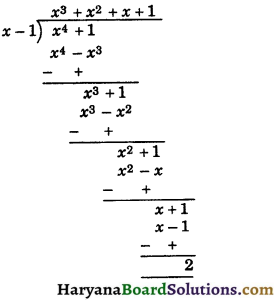
Hence, remainder = 2.
Question 5.
If p(x) = 4x3 – 12x2 + 14x – 3, find the remainder when p(x) is divided by 2x – 1. Also, verify the result by actual division.
[NCERT Exemplar Problems]
Solution :
We have,
p(x) = 4x3 – 12x2 + 14x – 3
We know that when p(x) is divided by (2x – 1), the remainder is p(\(\frac {1}{2}\))
[By Remainder Theorem]
So,
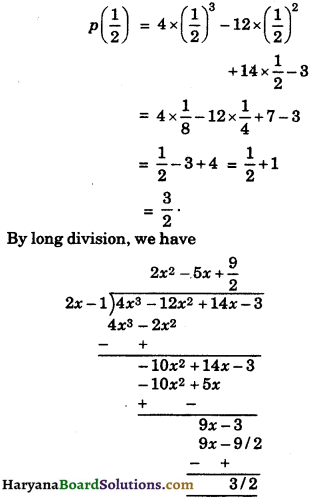
Remainder by actual division method is also \(\frac {3}{2}\)
Hence, the remainder in both cases is same.
Question 6.
When 4x3 + 18x2 + 14x + k is divided by 2x + 5, the remainder is 0. Find the value of k.
Solution :
Let p(x) = 4x3 + 18x2 + 14x + k is divided by (2x + 5), the remainder is 0.
By Remainder Theorem, remainder = p(\(\frac {-5}{2}\))
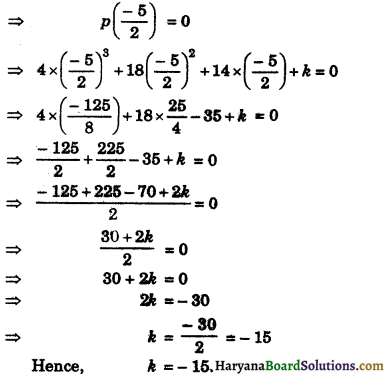
Question 7.
If the polynomials ax3 + 4z2 + 3z – 4 and z3 – 4z + a leave the same remainder when divided by z – 3, find the value of a.
Solution :
Let p(x) = az3 + 4z2 + 3z – 4
When p(z) is divided by (z – 3), the remainder is p(3)
∴ p(3) = a × (3)3 + 4 × (3)2 + 3 × 3 – 4
= 27a + 36 + 9 – 4
= 27a + 41
Let q(z) = z3 – 4z + a
When q(z) is divided by (z – 3), the remainder is q(3).
∴ q(3) = (3)3 – 4 × 3 + a
= 27 – 12 + a
= 15 + a
According to question, the remainders in both cases are equal.
⇒ p(3) = q(3)
⇒ 27a + 41 = 15 + a
⇒ 27 – a = 15 – 41
⇒ 26a = – 26
⇒ a = – \(\frac {26}{26}\)
⇒ a = – 1
Hence a = – 1
![]()
Question 8.
If the polynomial f(x) = x3 + px2 + qx – 10 is divided by (x – 3) and (x – 2) leaves the remainders 8 and – 12 respectively. Find the values of p and q.
Solution :
We have,
f(x) = x3 + px2 + qx – 10
When the given polynomial f(x) is divided by (x – 3), the remainder is 8.
By Remainder Theorem, the remainder = f(3)
⇒ f(3) = 8
⇒ (3)3 + p × (3)2 + q × 3 – 10 = 8
⇒ 27 + 9p + 3q – 10 = 8
⇒ 17 + 9p + 3q = 8
⇒ 9p + 3q = 8 – 17
⇒ 9p + 3q = – 9
⇒ 3p + q = – 3 …(i)
And when the given polynomial f(x) is divided by (x – 2), the remainder is – 12.
By Remainder Theorem, the remainder = f(2)
⇒ f(2) = – 12
⇒ (2)3 + p × (2)2 + q × 2 – 10 = – 12
⇒ 8 + 4p + 2q – 10 = – 12
⇒ 4p + 2q – 2 = – 12
⇒ 4p + 2q = – 12 + 2
⇒ 4p + 2q = – 10
⇒ 2p + q = – 5 ……..(ii)
Subtracting the equation (ii) from (i), we get

Putting the value of p in equation (ii), we get
2 × 2 + q = – 5
⇒ 4 + 9 = – 5
⇒ q = – 5 – 4
⇒ q = – 9
Hence, P = 2 and q = – 9.
Question 9.
Let R1 and R2 be the remainders when the polynomials kx3 + 3x2 – 14x + 5 and x3 – 5x2 + kx + 12 are divided by (x + 3) and (x – 2) respectively. If R1 – R2 = 16, then find the value of k.
Solution :
Let p(x) = kx3 + 3x2 – 14x + 5
When p(x) is divided by (x + 3), the remainder (R1) is p(-3).
[By Remainder Theorem]
R1 = p(-3)
R1 = k(-3)3 + 3(-3)2 – 14 × (- 3) + 5
R1 = – 27k + 27 + 42 + 5
R1 = – 27k + 74
And let q(x) = x3 – 5x2 + kx + 12
When q(x) is divided by (x – 2), the remainder (R2) is q(2).
(By Remainder Theorem)
⇒ R2 = q(2)
⇒ R2 = (2)3 – 5 × (2)2 + k × 2 + 12
⇒ R2 = 8 – 20 + 2k +12
⇒ R2 = 20 – 20 + 2k
⇒ R2 = 2k
According to question,
R1 – R2 = 16
⇒ – 27k + 74 – 2k = 16
⇒ – 29k = 16 – 74
⇒ – 29k = – 58
⇒ k = \(\frac {-58}{-29}\)
Hence, k = 2.
Question 10.
If both (x – 2) and (x – \(\frac {1}{2}\)) are factors of px2 + 5x + r, then show that p = r. (NCERT Exemplar Problems)
Solution :
Let f(x) = px2 + 5x + r
If (x – 2) is a factor of f(x), then by factor theorem, the remainder f(2) should be zero.
⇒ f(2) = 0
⇒ p × (2)2 + 5 × 2 + r = 0
⇒ 4p + 10 + r = 0 ……(i)
If (x – \(\frac {1}{2}\)) is a factor of f(x), then by factor theorem, the remainder f(\(\frac {1}{2}\)) should be zero.
⇒ f(\(\frac {1}{2}\)) = 0
⇒ p × (\(\frac {1}{2}\))2 + 5 × \(\frac {1}{2}\) + r = 0
⇒ \(\frac{p}{4}+\frac{5}{2}\) + r =0
⇒ p + 10 + 4r = 0 ……….(ii)
From equations (i) and (ii), we get
4p + 10 + r = P + 10 + 4r
⇒ 4p + r = p + 4r
⇒ 4p – p = 4r
⇒ 3p = 3r
⇒ p = \(\frac {3r}{3}\) = r
Hence, P = r. Hence Proved.
![]()
Question 11.
What must be subtracted from 3x3 – 11x2 + 11x – 10 to obtain a polynomial which is exactly divisible by (x – 3).
Solution :
Let f(x) = 3x3 – 11x2 + 11x – 10
Let k be subtracted from f(x), so that it may be exactly divisible by (x – 3).
∴ p(x) = 3x3 – 11x2 + 11x – 10 – k
If p(x) is exactly divisible by (x – 3), then by factor theorem, the remainder p(3) should be zero.
⇒ p(3) = 0
⇒ 3 × (3)3 – 11 × (3)2 + 11 × 3 – 10 – k = 0
⇒ 81 – 99 +33 – 10 – k = 0
⇒ 114 – 109 – k = 0
⇒ 5 – k = 0
⇒ k = 5
Hence, 5 must be subtracted from the given polynomial.
Question 12.
If x + \(\frac {1}{x}\) = 5, find the values of each of the following:
(i) x2 + \(\frac{1}{x^2}\)
(ii) x4 + \(\frac{1}{x^4}\)
Solution :
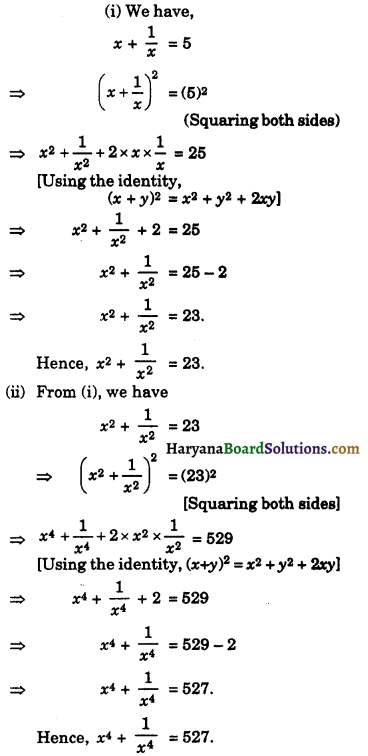
Question 13.
If x2 + \(\frac{1}{x^2}\) = 34, find the values of each of the following :
(i) x + \(\frac {1}{x}\)
(ii) x3 + \(\frac{1}{x^3}\)
Solution :
(i) We have,
x2 + \(\frac{1}{x^2}\) = 34
⇒ x2 + \(\frac{1}{x^2}\) + 2 = 34 + 2 [Adding 2 on both sides]
⇒ x2 + \(\frac{1}{x^2}\) + 2 × x × \(\frac {1}{x}\) = 36
⇒ (x + \(\frac {1}{x}\))2 = (6)2
[Using the identity, x2 + y2 + 2xy = (x+y)2]
⇒ x + \(\frac {1}{x}\) = ± 6
[Taking square root on both sides]
Hence, x + \(\frac {1}{x}\) = ± 6.
(ii) From (i), we have
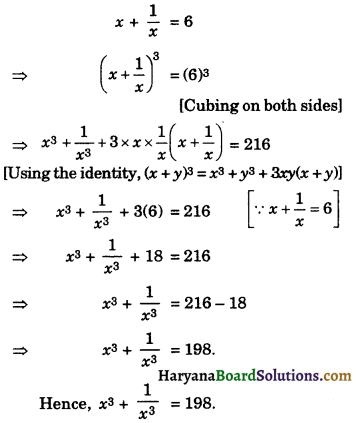
Question 14.
If x + y = 7 and x2 + y2 = 25, find the value of x3 + y3.
Solution :
We have,
x + y = 7
⇒ (x + y)2 = (7)2
[Squaring on both sides]
⇒ x2 + y2 + 2xy = 49
⇒ 25 + 2xy = 49, [∵ x2 + y2 = 25]
⇒ 2xy = 49 – 25
⇒ 2xy = 24
⇒ xy = \(\frac {24}{2}\) = 12.
Now, we have(x + y) = 7
⇒ (x + y)3 = (7)3
(Cubing on both sides)
⇒ x3 + y3 + 3xy(x + y) = 343
[Using the identity, (x + y)3 = x3 + y3 + 3xy(x + y)]
⇒ x3 + y3 + 3 × 12(7) = 343,
[∵ x + y = 7 and xy = 12]
⇒ x3 + y3 + 252 = 343
⇒ x3 + y3 = 343 – 252
⇒ x3 + y3 = 91.
Hence, x3 + y3 = 91.
![]()
Question 15.
If a2 + b2 + c2 = 14 and a + b + c = 6, find ab + bc + ca.
Solution :
We have,
a + b + c = 6
⇒ (a + b + c)2 = (6)2
(Squaring on both sides)
⇒ a2 + b2 + c2 + 2ab + 2bc + 2ca
⇒ 14 + 2(ab + bc + ca) = 36,
[∵ a2 + b2 + c2 = 14]
⇒ 2(ab + bc + ca) = 36 – 14
⇒ 2(ab + bc + ca) = 22
⇒ ab + bc + ca = \(\frac {22}{2}\)
⇒ ab + bc + ca = 11
Hence, ab + bc + ca = 11.
Question 16.
Evaluate each of the following by using suitable identity :
(i) \(\frac{0.94 \times 0.94 \times 0.94+0.06 \times 0.06 \times 0.06}{0.94 \times 0.94-0.94 \times 0.06+0.06 \times 0.06}\)
(ii) \(\frac{2.05 \times 2.05 \times 2.05-0.05 \times 0.05 \times 0.05}{2.05 \times 2.05+2.05 \times 0.05+0.05 \times 0.05}\)
(iii) 1053 + 953
Solution :
We use the identity in each of the following [(i) to (iv)] :
(i) x3 + y3 = (x + y) (x2 – xy + y2)
(ii) x3 – y3 = (x – y) (x2 + xy + y2)
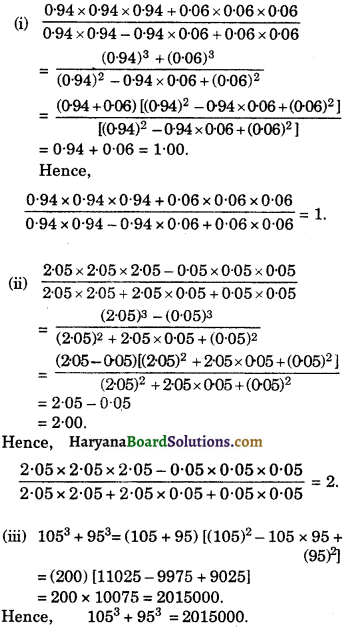
Question 17.
If 3x + 4y = 18 and xy = 6, then find the value of 27x3 + 64y3.
Solution :
We have,
3x + 4y = 18
⇒ (3x + 4y)3 = (18)3 (Cubing on both sides)
⇒ 27x3 + 64y3 + 3 × 3x × 4y(3x + 4y) = 5832
[Using the identity, (x + y)3 = x3 + y3 + 3xy(x + y)] +
⇒ 27x3 + 64y3 + 36xy(18) = 5832, (∵ 3x + 4y = 18)
⇒ 27x3 + 64y3 + 36 × 6 × 18 = 5832
⇒ (∵ xy = 6)
⇒ 27x3 + 64y3 + 3888 = 5832
⇒ 27x3 + 64y3 = 5832 – 3888
⇒ 27x3 + 64y3 = 1944.
Hence, 27x3 + 64y3 = 1944.
![]()
Question 18.
If a + b + c = 3, abc = – 12 and ab + bc + ca = – 4, find the value of a3 + b3 + c3.
Solution :
We have, a + b + c = 3 …(i)
⇒ (a + b + c)2 = (3)2
(Squaring on both sides)
⇒ a2 + b2 + c2 + 2ab + 2bc + 2ca = 9
⇒ a2 + b2 + c2 + 2(ab + bc + ca) = 9
⇒ a2 + b2 + c2 + 2 × (- 4) = 9
[∵ ab + bc + ca = – 4]
⇒ a2 + b2 + c2 – 8 = 9
⇒ a2 + b2 + c2 = 9 + 8 = 17 ………(ii)
We know that,
a3 + b3 + c3 – 3abc = (a + b + c)(a2 + b2 + c2 – ab – bc – ca)
⇒ a3 + b3 + c3 – 3 × (- 12) = 3 × [17 – (ab + bc + ca)],
[∵ From (ii), a2 + b2 + c2 = 17, abc = – 12 and a + b + c = 3 (given)]
⇒ a3 + b3 + c3 + 36 = 3 × [17 – (-4)]
⇒ [∵ ab + bc + ca = – 4]
⇒ a3 + b3 + c3 + 36 = 3 x 21
⇒ a3 + b3 + c3 + 36 = 63
⇒ a3 + b3 + c3 = 63 – 36
⇒ a3 + b3 + c3 = 27.
Hence, a3 + b3 + c3 = 27.
Question 19.
Factorise : x2 + \(\frac{1}{x^2}\) + 3 – 2x – \(\frac {2}{x}\)
Solution :
= x2 + \(\frac{1}{x^2}\) + 3 – 2x – \(\frac {2}{x}\)
= x2 + \(\frac{1}{x^2}\) + 2 + 1 – 2x – \(\frac {2}{x}\)
= (x + \(\frac {1}{x}\))2 + 1 – 2(x + \(\frac {1}{x}\))
[Using the identity, x2 + y2 + 2xy = (x + y)2
= a2 + 1 – 2a, where a = x + \(\frac {1}{x}\)
= (a – 1)2
= (a – 1) (a – 1)
= (x + \(\frac {1}{x}\) – 1) (x + \(\frac {1}{x}\) – 1)
Hence, x2 + \(\frac{1}{x^2}\) + 3 – 2x – \(\frac {2}{x}\)
= (x + \(\frac {1}{x}\) – 1) (x + \(\frac {1}{x}\) – 1)
Question 20.
If a + b + c = 3x, then prove that: (x – a)3 + (x – b)3 + (x – c)3 – 3(x – a) (x – b) (x – c) = 0.
Solution :
We have,
a + b + c = 3x
⇒ a + b + c = x + x + x
⇒ (x – a) + (x – b) + (x – c) = 0
We know that, if x + y + z = 0, then
x3 + y3 + z3 = 3xyz
Since,(x – a) + (x – b) + (x – c) = 0
Therefore, (x – a)3 + (x – b)3 + (x – c)3
= 3(x – a)(x – b)(x – c)
⇒ (x – a)3 + (x – b)3 + (x – c)3 – 3(x – a)(x – b)(x – c) = 0.
Hence proved
Question 21.
Factorise : x12 – y12
Solution :
x12 – y12 = (x6)2 – (y6)2
= (x6 + y6) (x6 – y6)
[Using the identity, x2 – y2 = (x + y)(x – y)]
= [(x2)3 + (y2)3] [(x3)2 + (y3)2]
= (x2 + y2) [(x2)2 – x2y2 + (y2)2] (x3 + y3) (x3 – y3)
[Using the identity,
x3 + y3 = (x + y) (x2 – xy + y2)]
= (x2 + y2) (x4 – x2y2 + y4)(x + y) (x2 – xy + y2) (x – y)(x2 + xy + y2)
= (x + y) (x – y) (x2 + y2) (x2 – xy + y2) (x2 + xy + y2) (x4 – x2y2 + y4)
Hence, x12 – y12 = (x + y) (x – y) (x2 + y2)
(x2 – xy + y2) (x2 + xy + y2) (x4 – x2y2 + y4).
![]()
Question 22.
If x = y = 333 and z = 334, find the value of x3 + y3 + z3 – 3xyz, without actually calcuting cubes.
Solution :
We know that,
x3 + y3 + z3 – 3xyz = (x + y + z) (x2 + y2 + z2 – xy – yz – zx)
= \(\frac {1}{2}\) (x + y + z) [2(x2 + y2 + z2 – xy – yz – zx)]
= \(\frac {1}{2}\) (x + y + z) (2x2 + 2y2 + 2z2 – 2xy – 2yz – 2zx)
= \(\frac {1}{2}\) (x + y + z) (x2 + y2 – 2xy + y2 + z2 – 2yz + z2 + x2 – 2zx]
= \(\frac {1}{2}\) (x + y + z) [(x – y)2 + (y – z)2 + (z – x)2]
= \(\frac {1}{2}\) (333 + 333 + 334) [(333 – 333)2 + (333 – 334)2 + (334 – 333)2]
[it is given that x = 333, y = 333 and z = 334)
= \(\frac {1}{2}\) (1000) (0 + 1 + 1)
= \(\frac {1}{2}\) (1000) × 2 = 1000
Hence,
x3 + y3 + z3 – 3xyz = 1000.
Question 23.
Find the remainder when 6x3 + 12x2 – 9x – 3 is divided by x + \(\frac {2}{3}\)
Solution :
Let p(x) = 6x3 + 12x2 – 9x – 3
We know that when p(x) is divided by (x + \(\frac {2}{3}\)) the remainder is p(\(\frac {-2}{3}\))
[By Remainder Theorem]
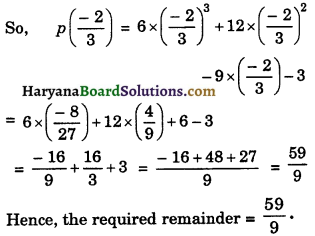
Question 24.
Find p(0),p(-1) and p(-2) for each of the following polynomials :
(i) p(x) = 2x3 – 7x + 9
(ii) p(y) = 4y2 + 3y – 2
Solution :
(i) We have,
p(x) = 2x3 – 7x + 9
p(0) = 2 × (0)3 – 7 × 0 + 9
= 0 – 0 + 9 = 9.
p(-1) = 2 × (-1)3 – 7 × (-1) + 9
= 2 × (-1) + 7 + 9
= – 2 + 7 + 9
= 14.
and p(-2) = 2 × (-2)3 – 7 × (-2) + 9
= – 16 + 14 + 9 = 7
Hence, p(0) = 9, p(-1)= 14 and p(-2) = 7.
(ii) We have,
p(y) = 4y2 + 3y – 2
p(0) = 4 × (0)2 + 3 × 0 – 2
= 0 + 0 – 2 = – 2.
p(-1) = 4 × (-1)2 + 3 × (-1) – 2
= 4 – 3 – 2 = – 1.
and p(-2) = 4 × (-2)2 + 3 × (-2) – 2
= 16 – 6 – 2
= 16 – 8 = 8.
Hence, p(0) = – 2, p(-1) = – 1
and p(-2) = 8.
Long Answer Type Questions
Question 1.
If the polynomial p(x) = x4 – 3x3 + x2 + ax + b is divided by (x – 1) and (x + 1) leaves the remainders 13 and 9 respectively, find the values of a and b. Hence, find the remainder when p(x) is divided by (x – 2).
Solution :
We have,
p(x) = x4 – 3x3 + x2 + ax + b
When the given polynomial p(x) is divided by (x – 1), the remainder is 13.
By Remainder Theorem, the remainder = p(1)
⇒ P(1) = 13
⇒ (1)4 – 3 × (1)3 + (1)2 + a × 1 + b = 13
⇒ 1 – 3 + 1 + a + b = 13
⇒ – 1 + a + b = 13
⇒ a + b = 13 + 1
⇒ a + b = 14 …(i)
And when the given polynomial p(x) is divided by (x + 1), the remainder is 9.
By Remainder Theorem, the remainder = P(-1)
⇒ p(-1) = 9
⇒ (-1)4 – 3 × (-1)3 + (-1)2 + a × (-1) + b = 9
⇒ 1 + 3 + 1 – a + b = 9
⇒ 5 – a + b = 9
⇒ – a + b = 9 – 5
⇒ – a + b = 4 …(ii)
Adding the equations (i) and (ii), we get
a + b = 14 …(i)
– a + b = 4 …(ii)
2b = 18
⇒ b = \(\frac {18}{2}\) = 9
Putting the value of b in equation (i), we get
a + 9 = 14
⇒ a = 14 – 9 = 5
Now, putting the values of a and b in the given polynomial p(x), we get
p(x) = x4 – 3x3 + x2 + 5x + 9
Now, p(x) is divided by (x – 2).
By Remainder Theorem,
the remainder = p(2).
So, p(2) = (2)4 – 3 × (2)3 + (2)2 + 5 × 2 + 9
= 16 – 24 + 4 + 10 + 9
= 39 – 24
= 15.
Hence, a = 5, b = 9 and p(2) = 15.
![]()
Question 2.
Find the values of p and q so that (x – 2) and (x + 3) are the factors of the polynomial
f(x) = 5x3 + 6x2 – px + q.
Solution :
We have,
f(x) = 5x3 + 6x2 – px + q
If (x – 2) is a factor of f(x), then by factor theorem, the remainder f(2) should be zero
⇒ f(2) = 0
⇒ 5 × (2)3 + 6 × (2)3 – p × 2 + q = 0
⇒ 40 + 24 – 2p + q = 0
⇒ 64 – 2p + q = 0
⇒ – 2p + q = – 64 …(i)
If (x + 3) is a factor of f(x), then by factor theorem, the remainder f(-3) should be zero.
⇒ f(-3) = 0
⇒ 5 × (-3)3 + 6 × (-3) -p × (-3) + q = 0
⇒ – 135 + 54 + 3p + q = 0
⇒ – 81 + 3p + q = 0
⇒ 3p + q = 81 …(ii)
Subtracting the equation (ii) from (i), we get
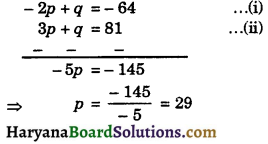
Putting the value of p in equation (ii), we get
3 × 29 + 9 = 81
⇒ 87 + q = 81
⇒ q = 81 – 87 = – 6
Hence, p = 29 and q = – 6.
Question 3.
Determine the values of h and k such that (x2 – 2x – 3) is a factor of the polynomial x3 – 3x2 + hx + k.
Solution :
Let p(x) = x3 – 3x2 + hx + k
Now, x2 – 2x – 3 = x2 – (3 – 1)x – 3
⇒ x2 – 2x – 3 = x2 – 3x + x – 3
⇒ x2 – 2x – 3 = x(x – 3) + 1(x – 3)
⇒ x2 – 2x – 3 = (x – 3)(x + 1)
If (x2 – 2x – 3) is a factor of p(x), then (x – 3) and (x + 1) are also the factors of p(x).
Now, (x – 3) is a factor of p(x), then by factor theorem, the remainder p(3) should be zero.
⇒ p(3) = 0
⇒ (3)3 – 3 × (3)2 + h × 3 + k = 0
⇒ 27 – 27 + 3h + k = 0
⇒ 3h + k = 0 ….(i)
And if (x + 1) is a factor of p(x), then by factor theorem, the remainder p(- 1) should be zero.
⇒ p(-1) = 0
⇒ (-1)3 – 3 x (-1)2 + h x (-1) + k = 0
⇒ – 1 – 3 – h + k = 0
⇒ – 4 – h + k = 0
⇒ – h + k = 4
⇒ h – k = – 4 ….(ii)
Adding equations (i) and (ii), we get
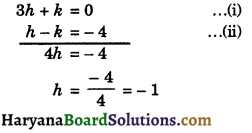
Putting the value of h in equation (ii), we get
– 1 – k = – 4
⇒ – k = – 4 + 1 = – 3
⇒ k = 3
Hence, k = 3 and h = – 1.
Question 4.
Without actual division, prove that x4 – 5x3 + 7x2 – 5x + 6 is exactly divisible by x2 – 5x + 6.
Solution :
Let p(x) = x4 – 5x3 + 7x2 – 5x + 6
And let
g(x) = x2 – 5x + 6
= x2 – (3 + 2)x + 6
= x2 – 3x – 2x + 6
= x(x – 3) – 2(x- 3)
= (x – 3)(x – 2)
If p(x) is exactly divisible by g(x), then p(x) is exactly divisible by (x – 3) and (x – 2) also.
Now, if p(x) is divisible by (x – 3), then by factor theorem, the remainder p(3) should be zero.
So, p(3) = (3)4 – 5 × (3)3 + 7 × (3)2 – 5 × 3 + 6
= 81 – 135 + 63 – 15 + 6
= 150 – 150 = 0
Therefore, p(x) is divisible by (x – 3).
⇒ (x – 3) is a factor of p(x). …(i)
And if p(x) is divisible by (x – 2), then by factor theorem, the remainder p(2) should be zero.
So, p(2) = (2)4 – 5 × (2)3 + 7 × (2)2 – 5 × 2 + 6
= 16 – 40 + 28 – 10 + 6
= 50 – 50 = 0
Therefore, p(x) is divisible by (x – 2).
⇒ (x – 2) is a factor of p(x). …(ii)
From (i) and (ii), we get
(x – 3)(x – 2) is a factor of p(x).
i.e., (x2 – 5x + 6) is a factor of p(x).
Hence, p(x) is exactly divisible by (x2 – 5x + 6). Proved
![]()
Question 5.
Factorise the following polynomials:
x4 + x3 – 7x2 – x + 6
Solution :
Ist method: Let
p(x) = x4 + x3 – 7x2 – x + 6
Factors of 6 are ±1, ±2, ±3, ±6.
Put x = 1
∴ p(1) = (1)4 + (1)3 – 7 × (1)2 – 1 + 6
= 1 + 1 – 7 – 1 + 6
= 8 – 8 = 0.
∴ By factor theorem, (x – 1) is a factor of p(x).
Now, divide x4 + x3 – 7x2 – x + 6 by (x – 1),
we get

So, x4 + x3 – 7x2 – x + 6 = (x – 1)(x3 + 2x2 – 5x – 6)
Other factor of p(x) is x3 + 2x2 – 5x – 6.
Factors of – 6 are ± 1, ± 2, ± 3, ± 6.
Again, put x = – 1
∴ p(-1) = (-1)3 + 2 × (-1)2 – 5 × (-1) – 6
= – 1 + 2 + 5 – 6
= 7 – 7 = 0.
∴ By factor theorem, (x + 1) is a factor of x3 + 2x2 – 5x – 6.
Again, divide x3 + 2x2 – 5x – 6 by (x + 1), we get

So, x3 + 2x2 – 5x – 6 = (x + 1) (x2 + x – 6)
And
x4 + x3 – 7x2 – x + 6 = (x – 1)(x + 1)(x2 + x – 6)
= (x – 1)(x + 1) [x2 + (3 – 2)x – 6]
= (x – 1)(x + 1)[x2 + 3x – 2x – 6]
= (x – 1)(x + 1) [(x2 + 3x) – (2x + 6)]
= (x – 1)(x + 1) (x(x + 3) – 2(x + 3)]
= (x – 1)(x + 1) (x + 3)(x – 2).
Hence, x4 + x3 – 7x2 – x + 6 = (x – 1)(x + 1) (x + 3)(x – 2).
IInd method: Let
p(x) = x4 + x3 – 7x2 – x + 6
Factors of 6 are = ± 1, ± 2, ± 3, ± 6
Put
x = 1
∴ p(1) = (1)4 + (1)3 – 7 × (1)2 – 1 + 6
= 1 + 1 – 7 – 1 + 6
= 8 – 8 = 0.
∴ By factor theorem, (x – 1) is a factor of p(x).
Again put x = – 1
∴ p(-1) = (-1)4 + (-1)3 – 7 × (-1)2 – (-1) + 6
= 1 – 1 – 7 + 1 + 6
= 8 – 8 = 0.
∴ By factor theorem, (x + 1) is a factor of p(x).
Again put x = 2
∴ p(2) = (2)4 + (2)3 – 7 × (2)2 – 2 + 6
= 16 + 8 – 28 – 2 + 6
= 30 – 30 = 0.
∴ By factor theorem, (x – 2) is a factor of p(x).
And put x = – 3 .
∴ p(-3) = (-3)4 + (-3)3 – 7 × (-3)2 – (-3) + 6
= 81 – 27 – 63 + 3 + 6
= 90 – 90 = 0.
∴ By factor theorem, (x + 3) is a factor of p(x). Now, since the given expression is of 4th degree, so it will have only four factors of first degree.
∴ x4 + x3 – 7x2 – x + 6 = k(x – 1) (x + 1) (x – 2) (x + 3) ……….(i)
Putting x = 0 (value of other than – 1, 1, 2, + 3) on both sides of equation (i), we get
+ 6 = k(-1)(1)(-2)(+3)
⇒ + 6 = 6k
⇒ k = \(\frac {6}{6}\) = 1
Putting the value of k in equation (i), we get
x4 + x3 – 7x2 – x + 6 = (x – 1) (x + 1) (x – 2) (x + 3)
Hence, x4 + x3 – 7x2 – x + 6 = (x – 1)(x + 1) (x – 2)(x + 3).
Question 6.
Factorise the following polynomials:
x4 – 4x3 – x2 + 16x – 12.
Solution :
Let
p(x) = x4 – 4x3 – x2 + 16x – 12
Factors of – 12 are ±1, ±2, ±3, ±4, ±6, ±12.
Put x = 1
∴ p(1) = (1)4 – 4 × (1)3 – (1)2 + 16 × 1 – 12 .
= 1 – 4 – 1 + 16 – 12
= 17 – 17 = 0.
∴ By factor theorem, (x – 1) is a factor of p(x).
Now, divide x4 – 4x3 – x2 + 16x – 12. by (x – 1), we get
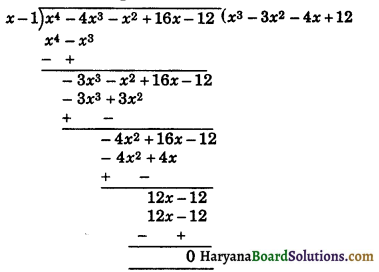
So,
x4 – 4x3 – x2 + 16x – 12 = (x – 1)(x3 – 3x2 – 4x + 12).
Other factor of p(x) is x3 – 3x2 – 4x + 12.
Factors of 12 are ±1, ±2, ±3, ±4, ±6, ±12
Again, put x = 2
∴ p(2) = (2)3 – 3 × (2)2 – 4 × 2 + 12
= 8 – 12 – 8 + 12
= 20 – 20 = 0.
∴ By factor theorem, (x – 2) is a factor of x3 – 3x2 – 4x + 12.
Now, divide x3 – 3x2 – 4x + 12 by (x – 2), we get
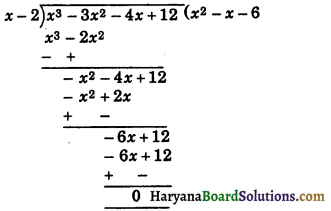
So,
x3 – 3x2 – 4x + 12 = (x – 2) (x2 – x – 6)
And x4 – 4x3 – x2 + 16x – 12 = (x – 1)(x – 2)(x2 – x – 6)
= (x – 1) (x – 2)[x2 – (3 – 2)x – 6]
= (x – 1) (x – 2)[x2 – 3x + 2x – 6]
= (x – 1) (x – 2)[(x2 – 3x) + (2x – 6)]
= (x – 1) (x – 2)[x(x – 3) + 2(x – 3)]
= (x – 1) (x – 2)(x – 3) (x + 2).
Hence, x4 – 4x3 – x2 + 16x – 12
= (x – 1)(x – 2)(x – 3)(x + 2).
![]()
Question 7.
If (x + 2) be a factor of the polynomial p(x) = kx3 + x2 – 12x – 4, then find the value of k and hence factorise the polynomial p(x).
Solution :
We have p(x) = kx3 + x2 – 12x – 4
If (x + 2) is a factor of p(x), then by factor theorem, p(-2) should be zero.
⇒ p(-2) = 0
⇒ k(-2)3 + (-2)2 – 12 × (-2) – 4 = 0
⇒ – 8k + 4 + 24 – 4 = 0
⇒ – 8k + 24 = 0
⇒ – 8k = – 24
⇒ k = \(\frac {- 24}{- 8}\) = 3
Putting the value of k in p(x), we get
p(x) = 3x3 + x2 – 12x – 4
According to question, (x + 2) is a factor of p(x).
Dividing 3x3 + x2 – 12x – 4 by (x + 2), we get
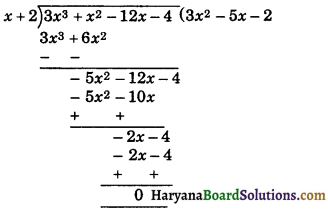
So, 3x3 + x2 – 12x – 4= (x + 2) (3x2 – 5x – 2)
= (x + 2) [3x2 – (6 – 1)x – 2]
= (x + 2) [3x2 – 6x + x – 2]
= (x + 2) [(3x2 – 6x) + (x – 2)]
= (x + 2) (3x(x – 2) + 1(x – 2)]
= (x + 2)(x – 2)(3x + 1).
Hence, k = 3 and 3x3 + x2 – 12x – 4 = (x + 2)(x – 2)(3x + 1).
Question 8.
If a4 + \(\frac{1}{a^4}\) = 322, find the value of a3 – \(\frac{1}{a^3}\).
Solution :
We have

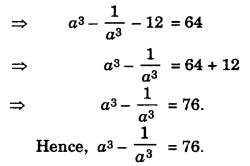
Question 9.
If a4 + \(\frac{1}{a^4}\) = 47, find the value of a3 + \(\frac{1}{a^3}\)
Solution :
We have,
a4 + \(\frac{1}{a^4}\) = 47
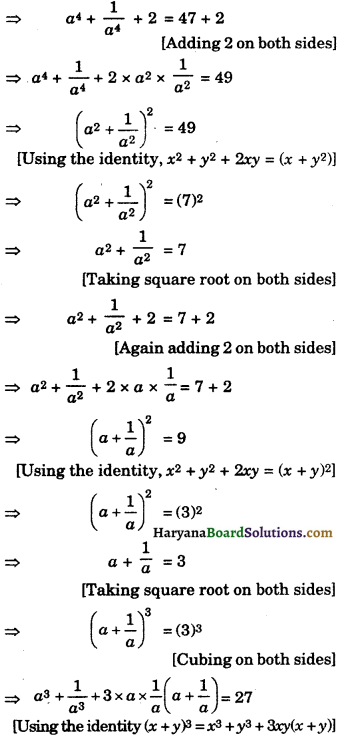

Question 10.
Factorise each of the following :
(i) (a – b)3 + (b – c)3 + (c – a)3
(ii)\(\frac{\left(p^2-q^2\right)^3+\left(q^2-r^2\right)^3+\left(r^2-p^2\right)^3}{(p-q)^3+(q-r)^3+(r-p)^3}\)
Solution :
We have,
(a – b)3 + (b – c)3 + (c – a)3
We know that if x + y + z = 0, then
x3 + y3 + z3 = 3xyz
Since, a – b + b – c + c – a = 0
Therefore, (a – b)3 + (b – c)3 + (c – a)3
= 3(a – b)(b – c) (c – a).
(ii) We have, \(\frac{\left(p^2-q^2\right)^3+\left(q^2-r^2\right)^3+\left(r^2-p^2\right)^3}{(p-q)^3+(q-r)^3+(r-p)^3}\)
We know that, if x + y + z = 0, then x3 + y3 + z3 = 3xyz
Since, p2 – q2 + q2 – r2 + r2 – p2 = 0
Therefore, (p2 – q2)3 + (q2 – r2)3 + (r2 – p2)3
= 3(p2 – q2) (q2 – r2) (r2 – p2) and p – q + q – r + r – p = 0
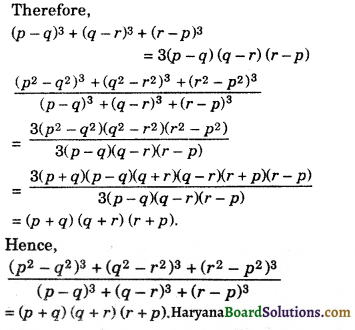
![]()
Question 11.
If \(\frac{x}{(b-c)(b+c-2 a)}=\frac{y}{(c-a)(c+a-2 b)}\) = \(\frac{z}{(a-b)(a+b-2 c)}\) then find the value of x + y + z.
Solution :
Let
\(\frac{x}{(b-c)(b+c-2 a)}=\frac{y}{(c-a)(c+a-2 b)}\) = \(\frac{z}{(a-b)(a+b-2 c)}\) = k
∴ x = k(b – c)(b + c – 2a),
y = k(c – a) (c + a – 26)
And z = k(a – b)(a + b – 2c)
Now, x + y + z = (b – c)(b + c – 2a) + k(c – a) (c + a – 2b) + k(a – b)(a + b – 2c)
= k[(b – c)(b + c – 2a) + (c – a)(c + a – 2b) + (a – b)(a + b – 2c)]
= k[b2 + bc – 2ab – bc – c2 + 2ac + c2 + ac – 2bc – ac – a2 + 2ab + a2 + ab – 2ac – ab – b2 + 2bc]
= k[b2 – c2 + c2 – a2 + a2 – b2 + bc – bc – 2ab + 2ab + 2ac – 2ac + ac – ac – 2bc + 2bc + ab – ab]
= k(0) = 0
Hence, x + y + z = 0.
Question 12.
Prove that : (a + b)3 + (b + c)3 + (c + a)3 – 3(a + b)(b + c) (c + a) = 2(a3 + b3 + c3 – 3abc).
Solution :
We have,
L.H.S. = (a + b)3 + (b + c)3 + (c + a)3 – 3(a + b)(b + c)(c + a)
Let, a + b = x, b + c = y, c + a = z, we get
L.H.S. = x3 + y3 + z3 – 3xyz
= (x + y + z)(x2 + y2 + z2 – xy – yz – zx)
= (a + b + b + c + c + a) [(a + b)2 + (b + c)2 + (c + a)2 – (a + b)(b + c) – (b + c)(c + a) – (c + a)(a + b)]
= 2(a + b + c) (a2 + b2 + 2ab + b2 + c2 + 2bc + c2 + a2 + 2ac – ab – ac – b2 – bc – bc – ab – c2 – ac – ac – bc – a2 – ab)
= 2(a + b + c) (2a2 + 2b2 + 2c2 – a2 – b2 – c2 + 2ab + 2bc + 2ca – 3ab – 3bc – 3ca]
= 2(a + b + c)(a2 + b2 + c2 – ab – bc – ca)
= 2(a3 + b3 + c3 – 3abc)
= R.H.S.
Hence, L.H.S. = R.H.S. Proved
Multiple Choice Questions
Choose the correct option in each of the following:
Question 1.
Which of the following is a polynomial in variable x?
(a) x + \(\frac {1}{x}\)
(b) \(\sqrt{x^2}+\frac{1}{\sqrt{x^2}}\)
(c) x2 + \(\frac{x^{3 / 2}}{\sqrt{x}}\)
(d) x3/2 + \(\frac{1}{\sqrt{x^2}}\)
Solution :
(c) x2 + \(\frac{x^{3 / 2}}{\sqrt{x}}\)
Question 2.
\(\sqrt{2}\) is a polynomial of degree: [NCERT Exemplar Problems]
(a) 2
(b) 0
(c) 1
(d) \(\frac {1}{2}\)
Solution :
(b) 0
Question 3.
Which of the following is binomial in y:
(a) y2 + 5
(b) y2 + 5y + 6
(c) y2 + \(\frac{1}{y^2}\) + 2
(d) y\(\sqrt{y}\) + 7
Solution :
(a) y2 + 5
![]()
Question 4.
Which of the following is trinomial in x:
(a) x3 + 1
(b) x3 + 3x
(c) x\(\sqrt{x^2}\) + \(\sqrt{x^2}\) + 7
(d) x3 + x2
Solution :
(c) x\(\sqrt{x^2}\) + \(\sqrt{x^2}\) + 7
Question 5.
Degree of a zero polynomial is [NCERT Exemplar Problems]
(a) 2
(b) 0
(c) 1
(d) not defined
Solution :
(d) not defined
Question 6.
Which of the following polynomial’s degree is zero?
(a) x2
(b) x + \(\frac {1}{x}\)
(c) 7
(d) x.
Solution :
(c) 7
Question 7.
Degree of the polynomial 27 + y2 – 3y3 + 5y5 is :
(a) 5
(b) 3
(c) 2
(d) o
Solution :
(a) 5
Question 8.
Zero of the polynomial p(x) = 2x + 5 is : [NCERT Exemplar Problems]
(a) –\(\frac {2}{5}\)
(b) – \(\frac {5}{2}\)
(c) \(\frac {2}{5}\)
(d) \(\frac {5}{2}\)
Solution :
(b) – \(\frac {5}{2}\)
Question 9.
If (x – 2) is a factor of x3 – 6×2 + 12x – k, then value of k is :
(a) 4
(b) 8
(c) 6
(d) 10
Solution :
(b) 8
Question 10.
If x120 + 4×143 + k is divisible by x + 1, then value of k is :
(a) 2
(b) – 2
(c) 3
(d) – 3
Solution :
(c) 3
Question 11.
(x + 1) is a factor of xn + 1, only if :
(a) n is a positive integer
(b) n is a negative integer
(c) n is an odd integer
(d) n is an even integer
Solution :
(c) n is an odd integer
![]()
Question 12.
If x51 + 51 is divided by x + 1, the remainder is: [NCERT Exemplar Problems]
(a) o
(b) 1
(c) 49
(d) 50
Solution :
(d) 50